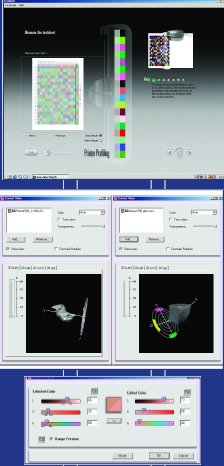articles/Printing/absolutepuzzle-page3
Absolute Puzzle - part 3 of 1 2 3 4
by Mike McNamee Published 01/08/2002

The saved image was later opened in Photoshop and because it was un-tagged with a profile we set it to sRGB. Close examination of the Histogram showed that we had set the shadow point accurately to about 10 RGB points. We were slightly under exposed in the highlights with a maximum value of 225 RGB points. Ideally we needed a tad more exposure but the studio had been occupied by another user by this time. A slight tweak of the Levels in Photoshop produced a very goodlooking Macbeth Chart and so we went ahead with the numerical analysis of the colour errors. These are shown in the table. The average error was 8.01. The Light Skin tone error was 1.22 making it indistinguishable from the original except by calculation.
The findings confirmed what we had always suspected, that digital can beat the pants off negative or transparency if it is handled correctly. We have no reason to suppose that other digital cameras will perform any differently.
How Good is the Final print?
Downstream from the shooting stage there are many places for your hard-won image data to be compromised. The Fuji Pictrograph produces a particularly pleasant rendering of skin tones and we were interested to actually place a figure of merit on its performance. We have examined a number of Pictrographs outputs, two printers in detail. The machine from the Leeds PhotoVisual (a PG4000) was profiled with three systems, Colour Vision ProfilerPro, X-Rite Digital Swatch Book (using Heidelberg Print Open) and Gretag Macbeth's Eye1 Profilemaker Pro. A PG 3000 had been profiled by Fuji staff using the Eye1 system. Before profiling we linearised the machines, that is calibrated them. This is not the same as profiling; linearisation ensures that the right amount of colour is deposited onto the print and that the steps between colour increments are even (ie 10% cyan to 15% cyan in the same relative change as 15% to 20% cyan). Profiling measures the colour performance over the whole output gamut and attempts to make the best overall compromises on fitting out-of-gamut colours into the colour space available on the printer.

There was a significant change in the visual quality of prints produced after profiling on both machines. This was confirmed by the spectrophotometer measurements and statistical analysis. In order to obtain a better understanding of the changes in the prints after profiling we plotted our data and did a lot of rocket science to analyse the results. We will not trouble the readers with this although a more in-depth paper is in preparation. Suffice to say that the average colour error across the whole Macbeth Chart was reduced from 14.9 to 7.9, the worst error was reduced from 29.4 to 14.4. The standard deviation, a statistical measure of the error variation, was halved from 6.8 to 3.4. The improvement in both the machines was about the same and the resulting print was judged by experienced observers to be of first class quality. The neutrality of the Pictrograph greys is so good that prints from it always look even better than the statistics might imply. We have samples of inkjet prints which measure up more accurately in statistical terms but the experienced viewer will tend to always rate the Pictrograph output more highly.
We also compared our values with a number of Macbeth Charts reproduced in photographic magazines concentrating our analysis on the light skin tones. The average error was 12.3 across eight magazines with the values ranging from
5.3 to 19.8. Interestingly the low value of
5.3 was obtained from a Fuji S1 Pro.
Detailed examination of the data also revealed that the major portion of the errors were in the lightness component, except for a scanned negative in which the bulk of the error came from the mismatch of the hue. Although we examined data from only three negative sets, all fared badly and were outperformed by digital cameras in almost all areas of the colour data. A 160 ASA Negative Emulsion (well) printed by a high street laboratory showed an average error of 11.5, about midway between the profiled and unprofiled PG3000.
Please Note:
There is more than one page for this Article.
You are currently on page 3 Contact Mike McNamee
1st Published 01/08/2002
last update 09/12/2022 14:50:45
More Printing Articles
There are 0 days to get ready for The Society of Photographers Convention and Trade Show at The Novotel London West, Hammersmith ...
which starts on Wednesday 15th January 2025





